When most people think of a brand, they think of a logo. A brand is much more than that (see our guide to completing your brand strategy for more on that). But a logo is certainly one of the most prominent pieces of a brand identity. It’s also one of the biggest creative challenges—beyond coming up with a brand name. How do you brainstorm ideas? How do you know it’s right for your brand? The process is a delicate mix of instinct, skill, and creativity. We’ve helped many brands bring their logo to life (or given it new life with a redesign), and each project has us starting from square one—the scariest square. But over time we’ve developed a logo design process that makes it easier, even enjoyable, for everyone involved. If you’ve been wondering how to design a logo, try this step-by-step guide to flex your creativity, use your team’s collective brainpower, and find something that truly reflects your brand.
But first, let’s discuss the word “logo.”

What Is a Logo?
Most people use the word “logo” to mean the visual stamp of a brand: the symbol, word, or both.
However, there is actually a specific distinction:
Logomark: The simple image that represents a brand (think Nike’s swoosh or Apple’s apple). For Column Five, it’s this:
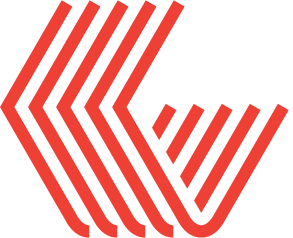
Logotype/wordmark: A brand name in a styled font (think Coca-Cola’s elaborate script or Gucci’s clean font).
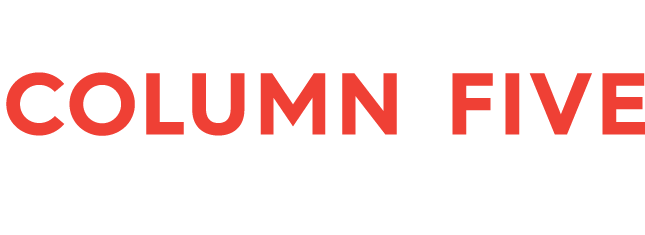 Combination mark: Both the image and the styled brand name together (think Puma).
Combination mark: Both the image and the styled brand name together (think Puma).

Now that there are more opportunities for visual branding, from favicons to Facebook cover photos, it’s more common for companies to have all three. For the purposes of this blog, we’ll talk about logomarks and logotypes, with the assumption that you will be designing a combination mark logo. So, on to the process.
How to Design a Logo
Good logo design relies on team collaboration and communication. The steps outlined here are meant to maximize your creative output while moving through the process in an intuitive way. Depending on your team, you may require more rounds of feedback in between, so feel free to tweak as needed.
Step 1: Know Who Needs to Be Involved
Your logo (as part of your entire visual identity) is an important tool to communicate your brand, so the process should include any brand stewards or decision-makers who oversee the brand. This doesn’t mean they have to submit their own logo designs, but it means you need to keep the right people in the loop.
How to Do It
Identify who needs to be involved at each stage, and ensure you get stakeholder approval before you move to the next stage. Trust us. There’s nothing more frustrating than going back to square one because somebody didn’t sign-off on an early logo design.
Step 2: Conduct a Brand Audit
Whether you’re collaborating with an agency or creating a logo in-house, this is the first step in the logo design process. A brand audit helps you get an intimate understanding of your brand, diving into your Brand Heart (purpose, vision, mission, values), goals, personas, messaging, and visual identity. This helps you articulate who you are and how you need to evolve, particularly if you’re doing a rebrand. With these insights, you can effectively design a logo that communicates your brand.
How to Do It
Download our free brand audit questionnaire, and follow our guide to conduct a brand audit. Be thorough and answer every question. Much of this information will inform your creative brief. (See step 3.)
Step 3: Write the Creative Brief
The logo design process can get messy if your team can’t come to a consensus, or if you can’t justify why a logo works. Thus, a creative brief is a crucial tool to keep your team aligned and on the same page.
Your brief is basically a distillation of your brand audit, allowing you to translate those answers into actionable design directions. A creative director or project manager is usually the person who creates the brief, but everyone involved with the logo design process should be familiar with it.
How to Do It
Here’s everything to include in your brief.
Step 4: Host a Free Association Brainstorm
Brainstorms can be the best part of the process, or they can be brutal. (You can also see our tips for conducting a better brainstorm to start off on the right foot.)
To help reduce the chaos, we recommend several brainstorms—each with a specific purpose, as outlined here. What matters is making sure you have the right deliverable at the end of each specific brainstorm so that you can move on to the next.
How to Do It
For this free association brainstorm, your goal is to create word clouds of brand descriptors that are inherently visual. (There’s no sketching at this phase.)
- Team needed: Your creative director(s), project manager, designers, and anyone else with knowledge of the brand. The more minds the better for this one, so you can even include people from accounting or HR.
- What you’ll do: Gather your team and a white board. Put 5-7 brand descriptors up on the board (e.g., friendly, helpful, enthusiastic, etc.). Hand out markers, then have the team do a free association exercise to come up with similar words or words inspired by any of your existing descriptors (e.g., friendly = kind, nurturing, generous, etc.). Have people list out as many as they can.

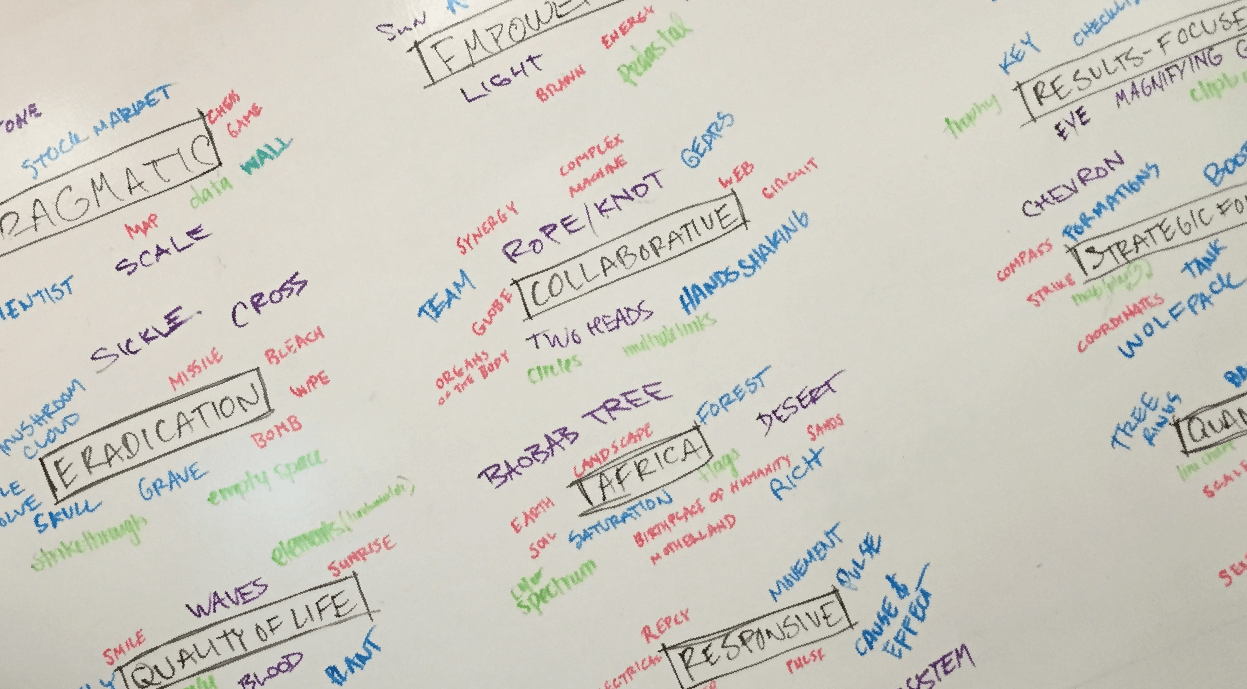
Once this exercise is complete, your creative director or project manager will identify the words that inspire the most visualization. These will be used in the next brainstorm.
Step 5: Have a Free Sketch Brainstorm
If your first brainstorm was fruitful, you should have a curated list of inspiring words for designers to work with. Now it’s time to start sketching a logomark. (You want to focus on your logomark first, then incorporate wordmark later.) Naturally, a good logo is a visual mark that reflects both what you do and who you are. There’s no one way to design one, but research has shown that different shapes can influence how people perceive your brand. This is important to consider, depending on the message you’re trying to communicate.
For example, studies by the Journal of Consumer Research and branding firm Siegel+Gale have found that:
Circular or organic shapes are associated with:
- Softness
- Kindness
- Warmth/caring
- Fun
- Freshness
- Friendliness
- Innovation
Geometric shapes are associated with:
- Hardness
- Durability
- Power
- Innovation
- Respect
- Intelligence
As you start to sketch your early-stage logo ideas, you may want to keep these ideas in mind.
Example: We created a new visual identity for the Expanded Special Project for Elimination of Neglected Tropical Diseases (ESPEN), a WHO organization on a mission to eliminate five specific tropical diseases. To bring their mission to life, we created a symbolic logo that features a rendering of the African continent, made of five bars: one for each disease they’re battling.
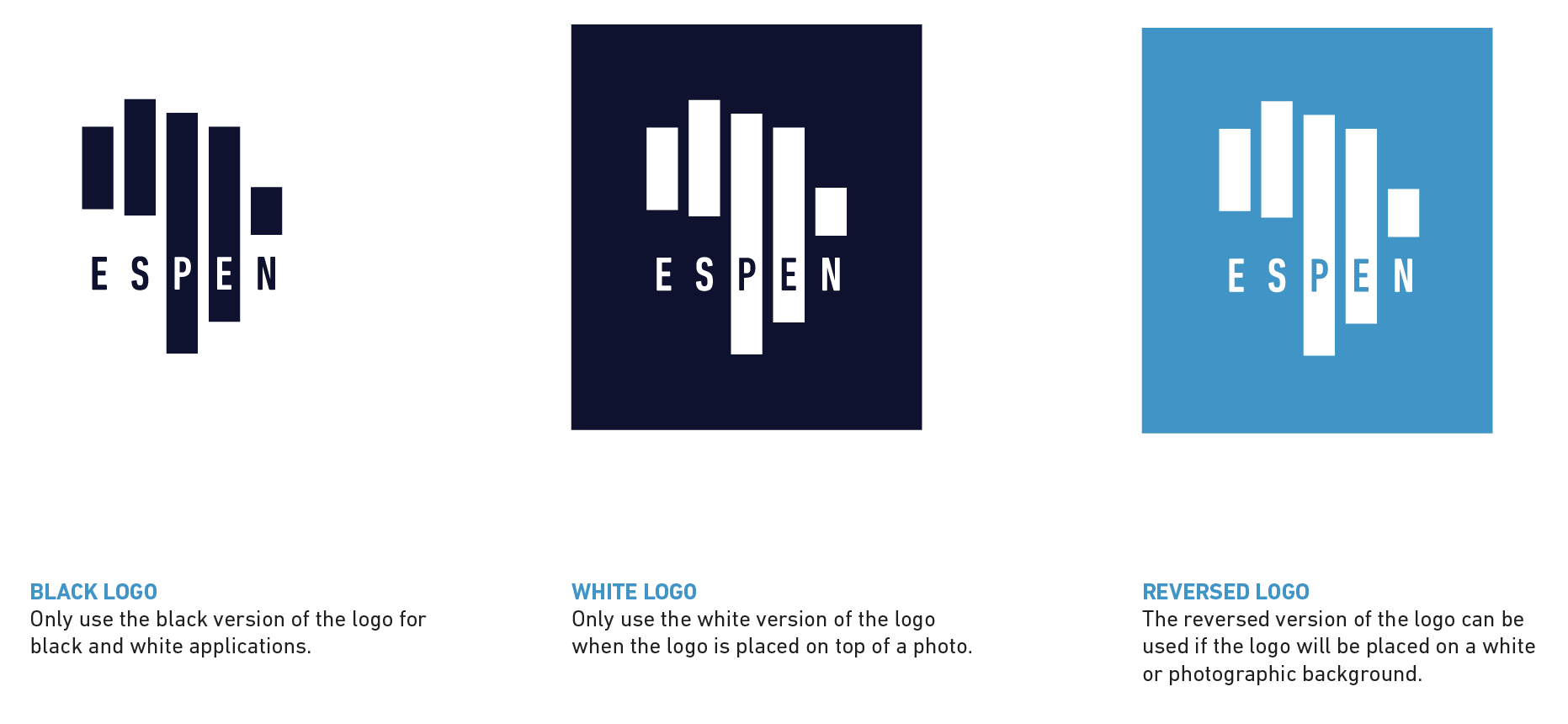
How to Do It
For your free sketch brainstorm, your goal is to translate concepts into visualizations.
- Team needed: Creative director(s), project manager, and designers.
- What you’ll do: Print out your bullet point list of inspiration words and put them up on a corkboard (or list them on a whiteboard). Roll out a bunch of paper and have your designers start sketching visual ideas inspired by the words (e.g., “helpful” might look like hands shaking, people hugging, or even a tow truck pulling something). Don’t be self conscious. You want as many visual ideas on paper as possible, no matter how ridiculous or off the wall.
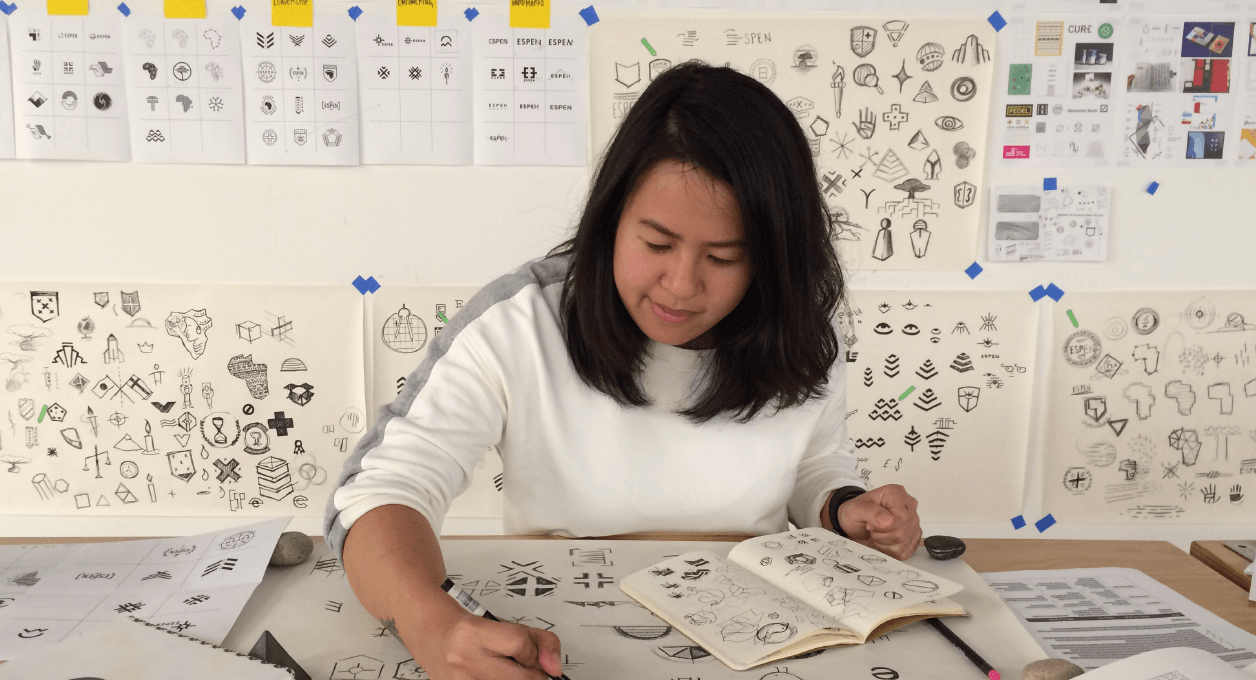
At the end of the session, the creative director should identify 25-30 concepts. You should also be able to group these visual concepts into 4-5 categories or themes. As you get feedback, you’ll likely see people gravitate toward a certain type of theme/category (e.g., “motion” or “human interaction”).
Step 6: Turn Sketches Into Vectors
This is where you start to see what type of logo will work in the real world. Note: No matter your design, it should be clear and simple enough to identify at a lower resolution or in smaller sizes, such as a Favicon or profile pic on social media.
How to Do It
Have the design team design turn those 25-30 sketches into simple black-and-white vectors.

You want to work in black and white for two very important reasons:
- The logotype/logomark should have a strong design foundation. Basically, it should work without the added dazzle of color.
- Color sways opinion. As you solicit rounds of feedback, color can distract or doom a perfectly great logo just because someone couldn’t see past that obnoxious orange.
Also, keep in mind that logomarks need to be legible in many applications (especially in tiny renderings, such as a favicon).
This simple exercise will likely exclude a few visual concepts, which is good. Your goal is to continue to narrow.
Step 7: Narrow It Down for Feedback
Now here’s the fun but tough part. (Get ready for a lot of opinions.) Note: The more options you give, the more overwhelmed people get. Hence, we suggest choosing a select group.
How to Do It
Distribute 3-5 truly workable options for feedback to necessary stakeholders. (Remember: You’re still only working on logomark at this point.) Distribute these options, gather collective feedback, then iterate for your next round.
Step 8: Present Your Frontrunners
With your collected feedback, you’ll narrow the group again. While there may be more discussions and opinions, remember that you’re looking for the logo that most effectively communicates your brand.
How to Do It
Narrow it down to your top 3 logomarks. If you’re having trouble narrowing it down, return to your brief. Vet each design through the lense of communication (not just pretty design).
Which makes the most impact? Which reflects who you are and what you do? You will also render your designs in color for a more finished look.
Once you have your 3 logomark options, you can play around with wordmark options. We say start with 10, which can be mixed and matched with all three logomarks.
Step 9: Test, Test, Test
With your top 3 frontrunners, it’s time to get even more feedback (yes, it can feel relentless) and create mockups: think packaging, landing pages, ads, etc.
How to Do It
If you want an easy way to test, you can adapt Steven Cook’s smart idea (originally for testing a brand name):
- Build a branded landing page for each logo. Use identical copy and only change logo.
- Run a highly targeted FB ad to your target customers for a week.
- See which page got more conversions.
There will likely be more discussions after this, but this can help you get a sense of what resonates.
Step 10: Finalize
Your testing and internal discussion should help you narrow down your official frontrunner. Once you have the winner, finalize your design details, and document how it should be effectively applied.
What If You Can’t Come to a Consensus?
No one said designing a logo is easy. If you find yourself heading back to the drawing board one more time, there are a few things that can help stoke your creativity:
- Get inspired by the awesome examples of logo design in our roundup of branding tools.
- Try these tips to get creatively unstuck.
- Learn how to work with the 4 types of creative thinkers if you feel like your team is having communication issues.
Above all, stick with it. Even if it takes more time, it’s better to create something everyone feels confident about. It may take a few more rounds, but eventually your team will come to a consensus.
Once Logo Is Done, Complete Your Visual Identity
Of course, your logo is just the first step in designing a comprehensive, cohesive visual identity. To complete your brand:
- Follow our guide to build a memorable brand identity (based on science).
- Bookmark these 100+ tools and tips to build a brand identity.
- Use our visual identity checklist to design a comprehensive identity that content creators can use across mediums.
- Learn how to find the right typography for your brand.
- Try our tips to curate the perfect color palette.
- Create a brand style guide that effectively communicates how to apply your brand guidelines.
- Find out how to make sure all your content is on brand.
And if you get stuck at any stage, don’t be afraid to bring in expert help. Follow our tips to find the right creative agency for you, find out what it’s like to work with us on a brand identity engagement, or holler at us. We’d love to help you bring your brand to life.



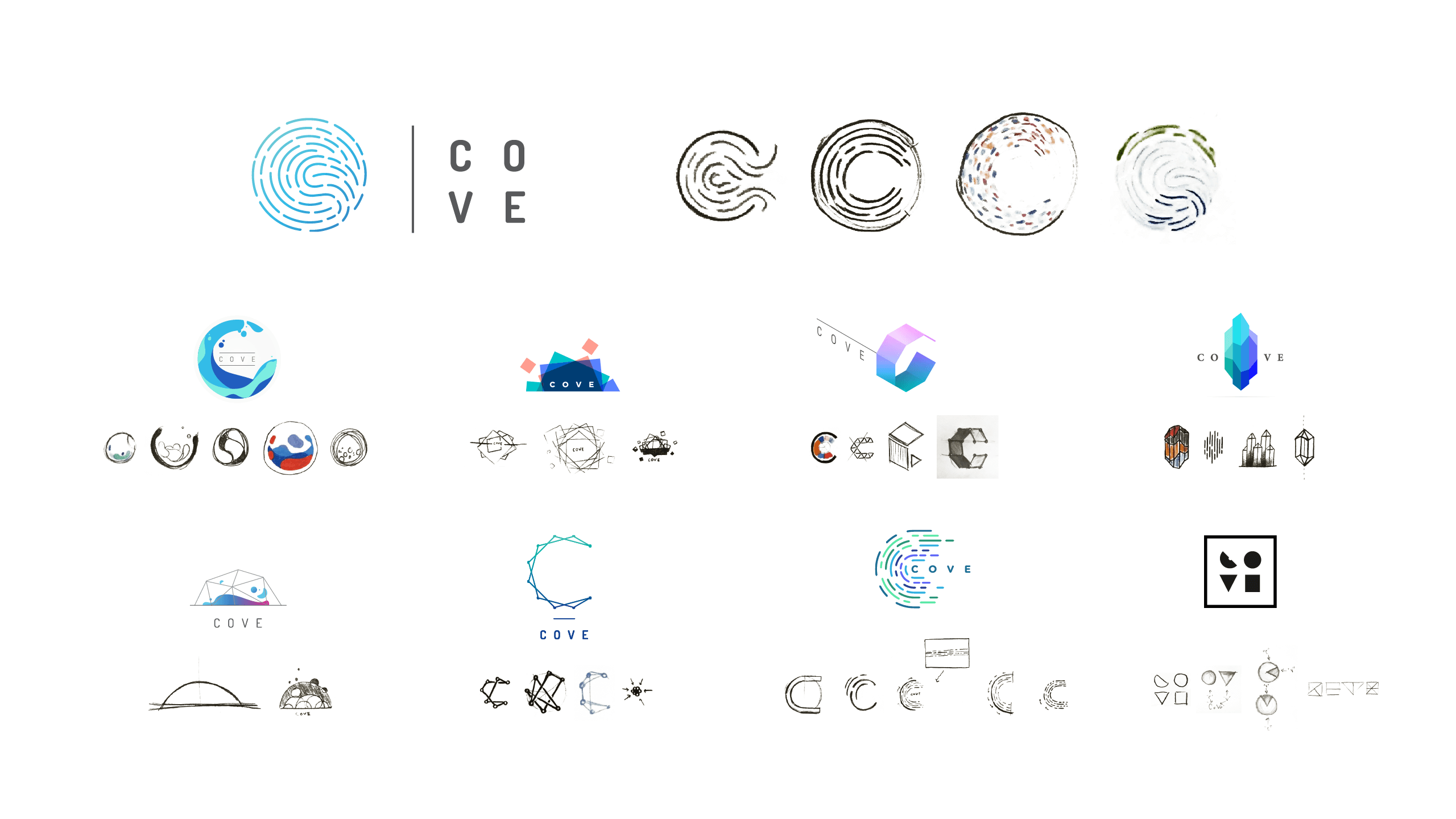



Excellent ! I personally like your blog and waiting for more articles like this
Happy to hear it!